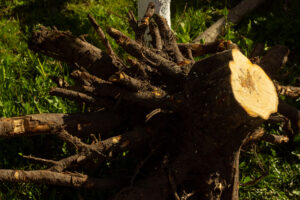Besides the cosmetic value they offer in our environment, trees provide our properties with a protective layer against adverse elements like strong windows.
Without trees, strong winds and typhoons can cause significant damage to property. However, the primary benefit of trees is to clean the dirty air and make it healthy for our breathing.
However, as beautiful and beneficial as they may be, some trees need to be taken down. When trees interfere with service lines like power, they become more of a limitation than a benefit.
Dead trees also need to be brought down before they fall on properties or roads where they would hamper traffic flow.
Even on your property, tree removal in NJ has to be done under the guidelines of municipalities. This article gives various reasons for why you need a permit for tree removal from your property in NJ municipalities.

Giant tree removal is our specialty!
Homeowners Associations
Most homes in NJ are under controlled development plans. The homeowners’ associations dictate how everything is done in such communities. You cannot just wake up and start hacking away trees in your property without proper communication with the association’s leadership or management. This is so because tree cutting interferes not just with your life, but also those of other people residing in those communities.
In such situations, you will be required to notify the association, which in turn notifies everyone else in the community about the hacking. After that, you will then inform the municipality. They will come to assess the situation and determine if the tree indeed needs to be felled. If the association in which you reside is okay with the removal, the municipality will then issue you with the right permits.
Protection of Rare Tree Species
The state of NJ boasts a diverse tree species and dense tree cover that helps in maintaining its breathtaking environment. The municipalities have in this understanding laid down stringent measures to minimize interference with the ecosystem. In this view, you will need to disclose more information about the tree species, its age, and the number of trees you intend to cut down. Even with all this information, the authorities may come to the site to verify its authenticity. All this is aimed at protecting the rare tree species that are fast becoming extinct.
Safety and Utility Lines
Tree removal near utility infrastructure for instance power, water, and gas will automatically attract permits for the process. As you are aware, installation of such lines takes a lot of time, and significant amounts of money are also spent. Besides, interference with such lines disrupts not just your life, but also that of those people in the community. Old trees pose a safety risk since upon falling, they can even damage subterranean utility infrastructure. Before issuing you with the right permits, your municipal authorities will first consult with the service companies to assess the need for the removal of such trees and the process involved.
Wetlands and Coastal Areas
Wetlands play a crucial role in the wildlife ecosystem by supporting different aquatic species. Even when the wetland is on your property, it is regulated by federal and state environmental agencies. Coastal areas, on the other hand, are high-traffic areas, hence the need to maintain public safety. Any tree removal in such areas, therefore, has to be done under stringent federal and state guidelines for which permits are issued.
Local Ordinances
Most local jurisdictions have their specific laws for tree removal. The laws are meant to safeguard federal and state regulations, local community ordinances, and the well-being of protected tree species and areas. Most of these laws change from time to time, so it is advisable to consult with the municipality websites for any updates. It is also worth noting these laws change depending on tree species, number of trees, specific community guidelines, and time of the year.
From wetlands and coastal areas, protection of rare tree species, local ordinances, and homeowners’ associations to service lines, there are various for reasons for obtaining permits for tree removal in NJ. Every jurisdiction in NJ has some form of tree removal laws for which permits must be issued. Since they change from time, consult with your municipal website for any updates on the same. Since navigating the intricate permit issuance process can sometimes be a hassle, most tree removal companies include permit services in their packages. Instead of assuming and getting into trouble for violating them, it is advisable to first confirm with the company when hiring the service.




